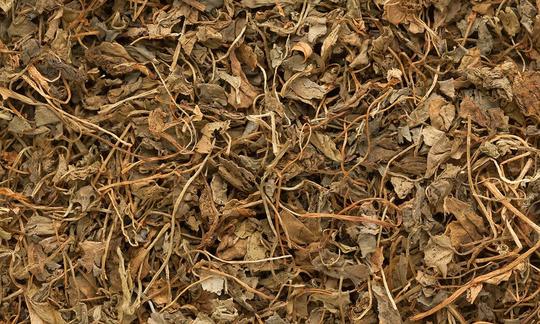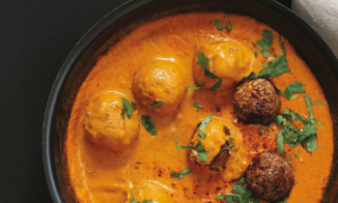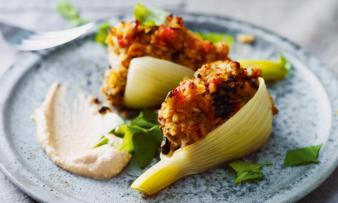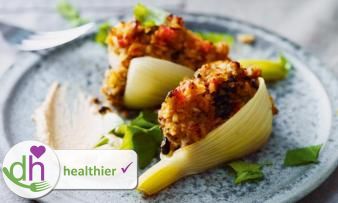Table of contents
Dried fenugreek leaves ( Trigonella foenum-graecum) or methi leaves are popular as a spice in many Indian and oriental dishes. In India, dried fenugreek is also known as kasuri methi ( kasoori methi).
Using Kasuri Methi in the kitchen:
The taste of dried fenugreek leaves is very characteristic and spicy-bitter. Some people also find the leaves reminiscent of maple syrup. The spice is therefore used sparingly. Cooking reduces the bitterness, but many recipes recommend adding it shortly before serving. In this case, it is a good idea to crush the dried methi leaves in a mortar beforehand.
The hay aroma, which is similar to lovage, goes particularly well with oriental dishes. Rice, sauces, vegan lentil or vegetable stews can be refined with dried or fresh fenugreek leaves. If you soak the dried leaves in water before use, they taste even more aromatic than the fresh, raw fenugreek herb. Savoy clover tastes milder.
Both the leaves and the seeds of fenugreek are used dried in many curry mixtures. Kasoori methi substitute: As an alternative to kasuri methi, you can use savory or dried mustard greens (possibly mixed with ground fenugreek seeds) and a little maple syrup or curry powder. Curry leaves have too different tastes and are therefore not suitable as a substitute for fenugreek leaves. In a pinch, cooked methi leaves can be replaced with spinach or finely chopped cabbage, although the flavor will be significantly different. 11
In South Tyrol, fenugreek seeds are used as a seasoning for bread and cheese. Germinated fenugreek seeds are valued like garden cress sprouts when eaten raw in salads or in cooking. 1
Making tea with fenugreek leaves (dried):
When making tea from fenugreek leaves, you need 1 teaspoon of the dried leaves per cup, as the flavor is very intense. Pour boiling water over the tea and let it brew for about 3 minutes. Fenugreek is also contained in many breastfeeding teas, as its ingredients stimulate milk production when consumed regularly. Even the seeds of fenugreek are used as tea (see link to fenugreek seeds).
Vegan recipe for vegetables with fenugreek leaves:
Ingredients (amount according to taste): Finely chopped onions, a little rapeseed oil, various finely chopped vegetables (such as zucchini, tomatoes, yellow bell peppers), spices such as grated ginger, finely chopped garlic cloves and chili flakes, raw coriander leaves, a pinch of dried fenugreek leaves, freshly ground (or powdered fenugreek seeds).
Preparation: For this recipe you need chopped onions, which you fry in a little rapeseed oil until they are translucent. Then you add the various chopped vegetables and spices. Finally, you add coriander leaves and a pinch of dried fenugreek leaves (or powdered fenugreek seeds) to flavor it. The vegetables can still be slightly crunchy when eaten.
Vegan recipes with Kasoori Methi can be found under the note: " Recipes that have the most of this ingredient ".
| Not only vegans or vegetarians should read this: Vegans often eat unhealthily. Avoidable nutritional mistakes. |
Shopping - where to buy Kasoori Methi?
Major retailers such as Coop, Migros, Denner, Volg, Spar, Aldi, Lidl, Rewe, Edeka, Hofer etc. rarely offer dried fenugreek leaves. You are most likely to find the dried spice (as fenugreek, dried) in health food stores, selected organic stores, in pharmacies, drugstores or on the Internet. Dried methi leaves can be bought as a spice or tea, because the packaging makes no difference for further use.
In many Asian shops you will find the Indian name Kasuri Methi ( Kasoori Methi). Some also offer the fenugreek leaves as dried methi leaves or as dried fenugreek leaves. You can also buy the powder online (e.g. as dehydrated green fenugreek leaves powder). Caution: this must be distinguished from the ground fenugreek seeds, which are confusingly also sold as 'ground fenugreek' (fenugreek powder, methi powder).
With organic quality, you can be sure that the product is not contaminated with pesticides or other sprays. Good places to buy gently dried spices in raw food quality (raw quality, dried at a maximum of 40 °C) are organic shops and health food stores.
Homemade Kasuri Methi:
Fresh fenugreek leaves can be gently dried in a dehydrator (food dehydrator) or in the air, or alternatively in the oven.
First, cut off the coarse stems and wash the methi leaves very thoroughly. Then spin them dry or pat them dry very well with a kitchen towel. In India, the method of drying the fenugreek leaves between two kitchen towels in the sun (always covered with a kitchen towel to avoid direct sunlight) is common. This takes at least 3-4 days.
According to traditional recommendations, the methi leaves are dried in the oven for 6-8 minutes at 180 degrees, but for raw food quality they need significantly longer (at lower temperatures: 2-3 hours at around 40 °C). The oven door should be left slightly open so that the moisture can escape. Drying in the microwave is not a gentle method and is also not recommended because it leads to a loss of aroma.
Found in the wild:
Fenugreek still grows wild in the eastern Mediterranean region to Central Asia, and also in southern and central Germany. It can be found at altitudes of up to 1000 m. 2
Dried fenugreek leaves: Storage
Like all spices, dried fenugreek leaves (Kasuri Methi) are sensitive to light, humidity and heat. Therefore, always store dried leaves in a dark, dry and cool place in a screw-top jar and use them within a year. Longer storage times will damage the aroma.
Ingredients - nutritional values - calories:
Fresh fenugreek leaves are particularly rich in calcium, vitamin A (as RAE) and vitamin C (depending on the growing conditions, even richer in vitamin C than fresh thyme 3). Therefore, you can also expect high concentrations in gently dried leaves. In general, dried spices have a very high nutrient content, but we usually only consume small amounts of them.
The coumarin contained in fenugreek leaves contributes to a sweet hay aroma when dried. 1 The chlorophyll content is particularly high in dried leaves (unless drought during growth has had a negative impact on it). 4
Health aspects - effects of Kasoori Methi:
Both the leaves and the seeds of fenugreek are used as medicinal drugs. 5 The seeds are currently enjoying particular popularity, although the leaves are somewhat less important. But they also need to be taken into account. They support health both internally and externally. The leaves are somewhat milder and have similar properties to the seeds, only in a weaker form. Fenugreek green leaves are one of the oldest medicinal remedies.
The biologically active substances contained in the leaves and seeds, such as proteins, amino acids, biogenic elements, fats and fatty acids, are used in traditional medicine, as functional food and in the cosmetics industry. Fenugreek leaves are used in traditional medicine for infusion preparations, water and alcohol extracts, tinctures, mead, tonics with antidepressant and psychotonic properties and as a nutritional supplement for muscle growth. 4
Bodybuilders make use of the stimulating effect on muscle growth. Fenugreek seeds are also said to influence the hormone balance. They are said to have a natural libido- and potency-enhancing effect. 6 Nevertheless, we are suspicious of the trendy term superfood because it is completely unspecific.
Dangers - Intolerances - Side effects:
Fenugreek preparations (whether seeds or leaves) are generally not recommended during pregnancy. Larger amounts can trigger premature labor and generally lead to gastrointestinal problems.
In 2011, a German organic gardening company imported contaminated fenugreek seeds from Egypt. These seeds were probably the source of the EHEC pathogen that caused the epidemic at the time (with life-threatening intestinal infections). There were around 53 deaths and hundreds of people became ill. 7 You can read more about this under the ingredient fenugreek seeds.
Use as a medicinal plant:
Fenugreek leaves are said to have an appetite-stimulating and pain-relieving effect when taken internally. Fenugreek tea is used for gastrointestinal complaints, respiratory diseases and rheumatism. 8 It is also said to help against bad breath. 9 If you have a persistent fever, extracts from fenugreek leaves help to reduce it after 1-2 hours. 10 Inflammation and edema can also be alleviated by taking it regularly, and during menopause, methi leaves are said to reduce symptoms. 2
The chlorophyll contained in the leaves ensures the formation of new blood cells, detoxifies and supports wound healing. 4
Folk medicine - natural medicine:
Indigenous peoples have known about the healing effects of fenugreek on skin problems and its blood-purifying effect for centuries. In Iran, it is said that fenugreek leaves help with eye diseases and gynecological illnesses.
Occurrence - Origin:
Based on findings from around 4,000 BC, the origin of fenugreek is thought to be in Persia, among other places. However, there are two opposing hypotheses in science (Mediterranean region or Asia as the origin). 13,14
Fenugreek is now found in southern Europe, Africa, the Middle East, India, China, the USA and Australia. The main producer is India (although it has a high domestic consumption). 13 The plant is rarely cultivated north of the Alps; 5 there are also small cultivation areas in Europe, 14 eg in Germany and France.
Cultivation - Harvest:
You can read more about the occurrence, cultivation and harvest of fenugreek under the ingredient fenugreek leaves, raw (methi). The raw, green, three-part methi leaves are harvested for fresh consumption or dried for longer storage and sale as kasuri methi (for making tea or as a spice 1).
Possible confusion:
Fresh fenugreek can easily be confused with other types of clover. Closely related and similar in taste is common savory ( Trigonella caerulea). However, the flower shape and color are different.
General information:
Fenugreek ( Trigonella foenum-graecum) belongs to the subfamily Faboideae and the legume family Fabaceae.
Essential oil is also made from fenugreek seeds. Mixed with other oils, it is used primarily to treat skin rashes and is said to help with hair loss. Fenugreek capsules are also available, which are said to contain all of the seeds' active ingredients in concentrated form.
In ancient times, fenugreek was used as a feed, food and natural remedy. Foenum-graecum means "Greek hay". 14 Even today, drought-tolerant fenugreek is an important source of feed for animals in countries such as Spain and Africa during periods of drought. 12
Alternative names:
What is Kasuri Methi? Important alternative names for dried fenugreek leaves are Kasuri Methi or Kasoori Methi. The component "Kasuri" is generally attributed to the discovery of the spice in the Kasur region in the Punjab province (now part of Pakistan).
Other names and/or common names for fenugreek are: Methya, Methika, Hulba, 14 Piskavica, Fännezwock, Fine Gret, Grieschheu, Grünschau, Kuhhornklee, Rehkörnli, Schöne Marie, Schöne Margreth, Siebenzeit, Siebenzeiten, Stundenkraut, Zeitkraut, Ziegenhornklee, Gelblicher Schabzigerklee, 5 Philosopher's clover or fenugreek etc. 12 In addition there are roe deer seeds, fine grete, filigracy and seven-cell seeds.
Literature - Sources:
Bibliography - 14 Sources (Link to the evidence)
| 1. | Quatmann C. Hausbuch der Kräuter. Der Gute Tip. SDK Verlag: Stuttgart. 1990. |
| 2. | Gesundheitswissen.de Bockshornklee: Bescheidene Pflanze mit vielseitiger Wirkung. |
| 3. | USDA United States Department of Agriculture. |
| 4. | Zuk-Golaszewska K, Wierzbowska J. Fenugreek: productivity, nutritional value and uses. Journal of Elementology. 2017;22(3). |
| 5. | Pahlow M. Das grosse Buch der Heilpflanzen. Gesund durch die Heilkräfte der Natur. Nikol Verlag. 2013. |
| 6. | Bockshornklee.info Natürliches Potenzmittel. |
| 7. | Bundesinstitut für Risikobewertung. Samen von Bockshornklee mit hoher Wahrscheinlichkeit für EHEC O104:H4 Ausbruch verantwortlich. 022/2011. |
| 8. | Gewürzkarawane.de Bockshornklee. |
| 9. | Bockshornklee.eu Bockshornklee – ein vielversprechendes Heilmittel. |
| 10. | Natur-kompendium.com Bockshornklee. |
| 11. | Thekitchencommunity.org Best Substitutes for Fenugreek Leaves. |
| 12. | Sprossen-Keimlinge.de Bockshornklee. |
| 13. | Zandi P, Basu SK, Cetzal-Ix W et al. Fenugreek (Trigonella foenum-graecum L.): An Important Medicinal and Aromatic Crop. In: El-Shemy H. (ed.). Active Ingredients from Aromatic and Medicinal Plants. IntechOpen. 2017. |
| 14. | Mehrafarin A, Rezazadeh SH, Naghdi Badi H et al. A Review on Biology, Cultivation and Biotechnology of Fenugreek (Trigonella foenum-graecum L.) as a Valuable Medicinal Plant and Multipurpose. Journal of Medicinal Plants. 2011; 10 (37). |








Comments